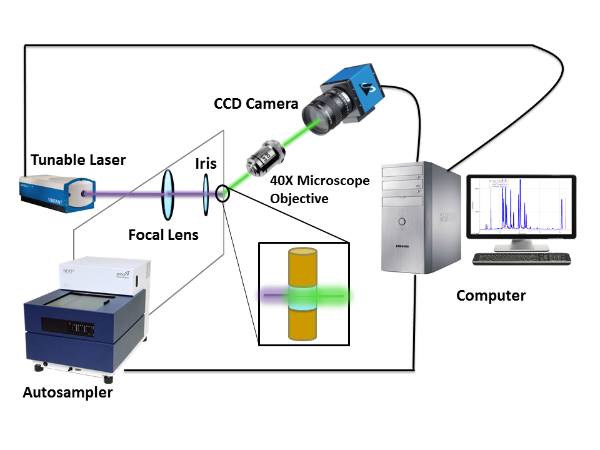Key Technologies
P-scan Urine Analyzer (345 Schrenk Hall): The P-scan urine analyzer is a high-throughput, automated capillary electrophoresis - laser-induced fluorescence (CE-LIF) technology designed for rapid urinalysis of biological pteridines that was developed in Dr. Yinfa Ma's laboratory. This patented technology is being used in multiple clinical trials to advance pteridine biomarker qualification from the U.S. Food and Drug Administration (FDA). Preliminary data associated with discerning benign and aggressive breast cancers have been particularly encouraging.

Single Nanoparticle ICP-MS technology (SP-ICP-MS) (225 Schrenk Hall): Nanotechnology offers great promise across many scientific disciplines and economic sectors. Novel nanoparticles (NPs) are developed continually, and nanomaterial research is extremely active throughout the world. Nanomedicine development, including nanomedicine for cancer therapy, is a rapidly growing field. The rapid development and broad applications of manufactured NPs have also raised significant concerns about the adverse effects of NPs on human health and the environment. As the rapid development of nanomaterials, advanced analytical technology and methodologies for testing and monitoring of NPs are in urgent need. However, the techniques for NP characterization and quantification in complex biomatrices and environmental samples, are limited or lacking. SP-ICP-MS is a cutting edge technology for nanomaterial characterization and quantification, essentially as a unique methodology for trace level quantification of metal enriched NPs.

CS3M aims to develop a number of methods to address these urgent analytical challenges. These advanced methods will advance the understanding of transport of nanomaterials in cells, tissues, and other biological fluids which will help biomedical researchers for drug delivery using nanomedicine. In addition, these methods will help environmental researchers to evaluate environmental impact of nanomaterials by providing data on transformations of nanomaterials in different environmental media, such as air, drinking water and waste water samples. Currently, a collaborative proposal “Cutting Edge Research and Applications by Modern NexION 300 ICP-MS: Single Nanoparticle Multi-Element ICP-MS Methods Development for Nanoparticle Characterization and Quantification” by Missouri S&T (PI Dr. Honglan Shi and Co-PIs Dr. Xinhua Liang and Jianmin Wang) and Perkin Elmer has been approved for collaborative research. A new NexION 300D ICP-MS (total cost $238,788) instrument from PerkinElmer has been installed at Missouri S&T to support this project and the other nanomaterial applications.
Single cell analyzer (SCA) (320 Schrenk Hall): In vitro quantitative measurements and analyses of various intracellular parameters is becoming an important aspect in cell research. Comprehensive understanding of a single cell in response to its biological environment and stimuli is becoming the foundation of many biomedical research fields, including drug development, nanotoxicity study, biomarker discovery, cancer diagnosis and treatment, and many other areas. However, there is no such instrumentation currently available to perform comprehensive and quantitative measurement of various key parameters inside a cell simultaneously. To address these limitations, the laboratories of Dr. Yinfa Ma and Dr. Honglan Shi have developed a novel multi-functional single-cell analyzer that integrates the capability of in vitro measurements of a number of important intracellular parameters. The new cell analyzer addresses a number of critical issues in biomedical research such as cell necrosis and apoptosis, stem cell differentiation, and cancer cell biology. Part of this project is currently supported by NIH and is progressing very well (through collaboration between Professors Yinfa Ma, Hai Xiao, and Honglan Shi). A multi-parameter nano sensing technology for detection of pHs, temperature and Raman spectroscopy in/on a single cell are under development.
Single Molecule Imaging System (SMIS) (331 Schrenk Hall). Single molecular imaging technologies have propelled researchers into new areas, including biological, chemical, physical, and material sciences. One of the important applications of SMIS is to serve as detection devices, such as real-time observation of low copy number proteins in a single cell. The vision fields and high-throughput characteristics of SMIS bring a profound influence for exploiting the molecular events. Ultimately, SMIS can be used in chemical analysis and for discovering the details of molecular environments that are indiscernible in bulk measurements. Current applications of SMIS focus mainly on detection and counting of molecules. A novel single cell-single molecule imaging system has been built in Dr. Yinfa Ma’s research laboratory. This SMIS has been used for nanotoxicity study, cancer biomarker screening and microfluidic and nanofluidic devices development.
Ultra-Fast Liquid Chromatography - Tandem Mass Spectrometry (UFLC-MS/MS) (345 Schrenk Hall): An AB SCIEX 4000 QTRAP hybrid QqLIT mass spectrometer coupled to a Shimadzu XR 20 series UFLC enables rapid quantitative and untargeted analyses of important biological and environmental analyes. This instrument is used to analyze many trace level compounds including large and small molecules such as proteins, pharmaceuticals and personal care products (PPCPs), water disinfection by-products (DBPs), pesticides and herbicides, explosives, and many more. The detection limit can reach part per billion(ppb) to part per trillion (ppt) for most compounds in multiple reaction monitoring (MRM) mode. In addition, the linear ion trap functionalities enable structure elucidation of unknown compounds.

Burton, Shi, & Ma. Analytical Chemistry, 85(22), 11137-11145 (2013).
